 Home
Home






Megajolt configurator software
The software is free to download and will run on any Windows laptop.
The Megajolt has communicates via serial RS232 using an RJ11 jack (previously a 9 pin D connector). Most computers will now need a serial to usb adapter which can be obtained, for example, on Ebay for less than a fiver.
You can download a map stored on your laptop, or the current map on your Megajolt. You can upload the current map to the Megajolt for testing. When you are happy with your map you can send it to flash memory in the Megajolt where it will remain until you want to store a new map.
To develop a map, you enter the range of manifold pressures you require 100 -
You then enter the advance values you think you need for each combination of pressure (normally knows as “vacuum”) Here is a useful article on ignition advance which might be helpful.
The values shown below don’t seem to be bad but they certainly might not be the best. Checking performance up a long hill with a consistent slope and a passenger with a stop watch would be helpful in assessing changes to the map. It’s useful to be able to enter two maps and flip between them with a switch. The thing to avoid is “pinking” or “knocking” which is a sort of almost metallic tinkling sound caused by a detonation of the petrol-
Pinking can damage or break your engine so is to be avoided! Engines with fuel injection have knock sensors which are like microphones on the engine tuned to pick up the characteristic sound of the knocking. When detected, the system reduces ignition advance until it goes away. This is why, I believe, high performance engines can run on low octane fuels. The higher the octane, the higher the compression ratio and the greater the ignition advance that can used without pinking. A higher compression ratio means a bigger bang and more power. Generally, the best power at any point comes with maximum ignition advance without knock. (I think I’m right there but don’t quote me!)
At maximum throttle and around maximum RPM (about 5500 -
There is a theory that increasing the advance at RPM just under idle speed can help to stabilise idling as if the speed drops, the extra advance will help to speed it up again. I’ve tried to implement this here. My Rover V8s seem to like to idle at around 900 RPM which seems a bit high for a reasonably large engine on a standard cam (?)
The picture below shows how you can set the programmable outputs and the shift light output to trigger at gradually increasing RPMs for my LED shift light display (which I have “gone off” but haven’t removed yet!)
At 100 RPM below the “rev limit” set, the system reduces the ignition advance an seriously reduces the engine power to prevent potential damage. The engine probably runs out of puff by 5500 RPM anyway.
Next is how to solve problems running the existing tachometers with Megajolt.